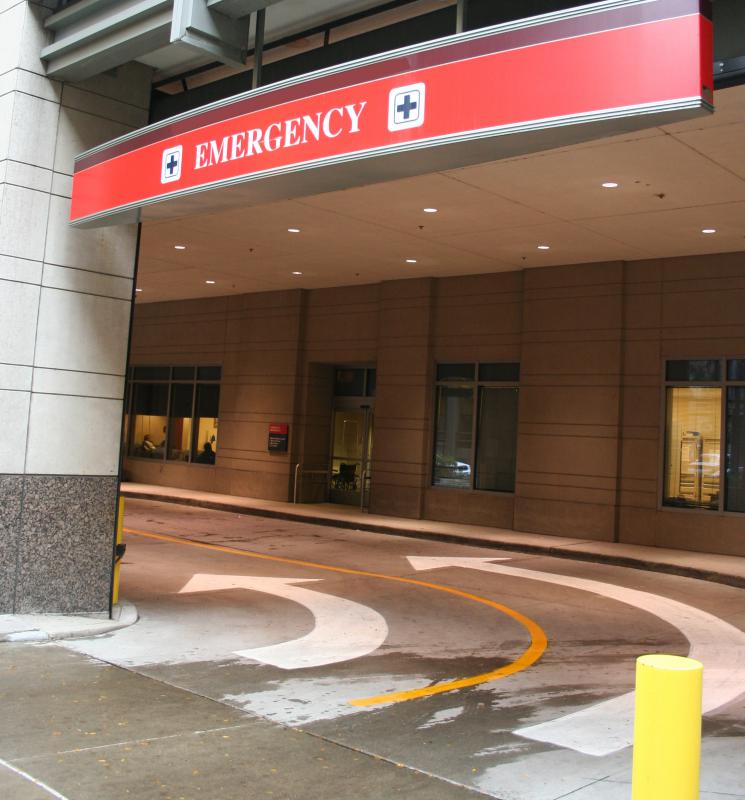At WiseGEEK, we're committed to delivering accurate, trustworthy information. Our expert-authored content is rigorously fact-checked and sourced from credible authorities. Discover how we uphold the highest standards in providing you with reliable knowledge.
What does an EMT do?
An emergency medical technician (EMT) is an individual who is trained to respond to emergency situations and perform lifesaving techniques until a patient can be transported to a hospital or treatment facility. Many are also responsible for the safe transfer of patients via ambulance from the scene of an accident or sudden illness to the closest medical facility. In most areas, they have to undergo intense training through a trade school or technical college and obtain a license.
Most times, an EMT works from his or her ambulance with one or two partners. They are given instructions via radio from a dispatcher, who gives them the locations of emergency situations and the types of illness of injuries if the information is available. The ambulance is generally equipped with commonly used lifesaving devices and medications, such as defibrillators, wound dressings, and drugs to control blood flow. EMTs must be physically capable and strong in order to lift and move patients and equipment.

There are four levels of EMT, each one having a different amount of training and experience. A level 1 is not licensed to transport patients, but can administer some lifesaving procedures in extreme cases. Many police officers or fire fighters are trained at this level. The next three levels are basic, intermediate, and paramedic. Generally a person begins work as a basic EMT and then continues schooling while also working on the field in order to complete training.

Some EMTs work for a private ambulance company, while others may be employed by a particular hospital or hospital system. Both have the same basic job description and usually similar pay-scales. Service quality is generally the same, as both those who work at hospitals and who are privately employed are trained in the same way and must pass the same licensing exams.

On average, these allied health professionals work a 24-hour workday, followed by 48 hours off. Much like firefighters, they often have a housing station where they can sleep in between calls, eat, and rest or shower. In some cases, they may work the entire 24 hours. A typical day on the job involves taking calls from a dispatcher and driving to the scene of an accident. Once there, they administer the necessary aid to revive or stabilize patients so that they can be loaded into the ambulance for care in an emergency room.
AS FEATURED ON:
AS FEATURED ON:
















Discussion Comments
Where is the easiest and least expensive place to take EMT classes? How long do most programs take to finish?
Also, is there a big demand for EMTs right now? I know that they are desperate for nurses but is this true for other hospital workers as well?
I worked as an EMT for a while but I had to leave the job after about 5 years because I was completely exhausting.
The emotional and physical toll the job takes on you is extreme. You work long hours, unusual shifts, and deal with some of the most intense and stressful situations you can imagine. Plus, you are dealing with life and death. There are real consequences for what you do.
It was rewarding work some of the time, but I couldn't have done it for much longer. My nerves were completely shot by the time I left.
@matthewc23 - That is quite interesting. I do not live in a small town, but I know several people who do live in small towns and they tend to have similar stories concerning EMT's.
It seems to me like they resemble members of a volunteer fire department in that they are simply on call, but it is not their everyday job.
I also know that most EMT's use their own vehicles and have a blue flashing light up front in order to respond to distress signals and they have the same power as ambulances, as people need to pull over and get out of their way.
I live in a small town and the EMT's in my area are simply people that are certified that live in town and are on call one certain days they are available.
They are usually called whenever an ambulance is also, as the nearest ambulance is not in my town, and they are usually the first ones to respond.
Most of the time these people are not fully licensed paramedics, but they have enough knowledge to be able to assist the person until the ambulance can take them away and in rare situations can even take the person themselves, if an ambulance cannot get there fast enough.
Post your comments